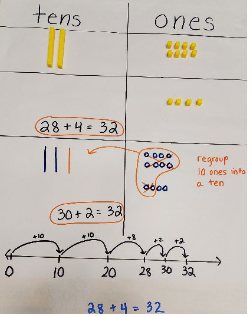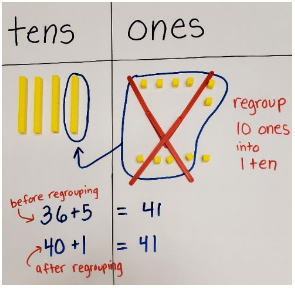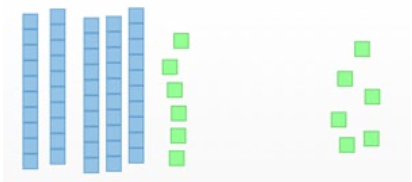General Information
Benchmark Instructional Guide
Connecting Benchmarks/Horizontal Alignment
Terms from the K-12 Glossary
- Expressions
- Equations
Vertical Alignment
Previous Benchmarks
Next Benchmarks
Purpose and Instructional Strategies
The purpose of this benchmark is for students to critically think about choosing a strategy that makes sense based on their given numbers. In Kindergarten, instruction focused on adding single digit whole numbers up to 10. Students recited number names to 100 and counted forward and backward within 20.- Instruction includes guiding students to appropriate and more efficient strategies. Strategies may include, but are not limited to, counting on, skip-counting, decomposing and composing, combining ones and tens, and composing new tens from ones when needed (MTR.2.1, MTR.5.1).
- The expectation for instruction does not include the use of an algorithm, but students should not be prevented from using an algorithm if they can use it reliably. However, the intent of this benchmark is for all students to deepen their understanding of place value while exploring addition. There is no expectation of procedural reliability until grade 2 within the range of this benchmark (MTR.5.1).
Common Misconceptions or Errors
- Students may inaccurately compose new tens when they have more than 9 ones. In these cases it is important for students to use concrete manipulatives such as base ten blocks as they exchange tens ones for a single ten rod in order to visually see the ones units making a new ten.
Strategies to Support Tiered Instruction
- Instruction includes the use of base ten blocks, place value chart, and number lines. Teacher provides an addition express with 2-digit and 1-digit addends and allows students to solve the addition problem with a manipulative and a representation.
- For example, teacher provides students with a problem like 28 + 4. Students may represent the addition problem using the base ten blocks on a place value chart. If they do not regroup, ask them if they can compose a group of ten ones.

- For example, teacher provides a problem like 64 + 7. Students may represent the addition problem on a number line. Using this representation shows that the student is counting on. Ask them if they notice how the digits change from 69 to 70 as they counted on the number line.

- Instruction includes the use of base ten blocks, place value chart and hundreds chart. Teacher provides a 2-digit number and has students build the number with the base ten blocks on the place value chart. Then, the teacher tells them that they are adding a 1-digit number to the number of blocks they already have. Teacher asks, “What number do you have now?” Exchange the 10 ones for 1 ten rod. Repeat with several problems with and without regrouping.
- For example, teacher provides students with the problem 36 + 5 and has students build 36 with base ten blocks and place on the place value chart. Then, students add 5 more ones to the chart. The teacher asks students, “What is your sum? Do you need to regroup?” Repeat with and without regrouping and ask if they need to regroup each time.

Instructional Tasks
Instructional Task 1 (MTR.4.1)
Pair students in groups of two and provide each group with the table below, two dice and base ten blocks (1 hundred mat, 12 tens rods per student, 20 ones per student).
- Part A. Students take turns rolling two dice to determine their starting number using one die to represent the tens place and one die to represent the ones place. Both students build their starting number with base ten blocks. The student who has the smallest starting number starts the game.
- Part B. The first student rolls a single die to add that amount to their starting number. The student writes the addition sentence they would use to get their new number. The student must decide if they have enough ones to exchange for a tens rod. If the student has 10 or more ones then they ask their partner to exchange their 10 ones for a tens rod.
- Part C. The student writes their new number down. Then they write that new number as their starting number on the next row but wait for their turn before completing the row.
- Part D. The second student rolls a single die and completes one row before the first student goes again.
Instructional Items
Instructional Item 1
To find 68 + 7, Jamal added 5 to 70 and got 75. Explain Jamal’s strategy. Is Jamal correct? Write another expression where his strategy can be used.Instructional Item 2
When adding 56 and 6 using base 10 blocks, Jasmine realized she now has 5 tens and 12 ones. What might be Jasmine’s next step to find the sum of 56 + 6?
*The strategies, tasks and items included in the B1G-M are examples and should not be considered comprehensive.
